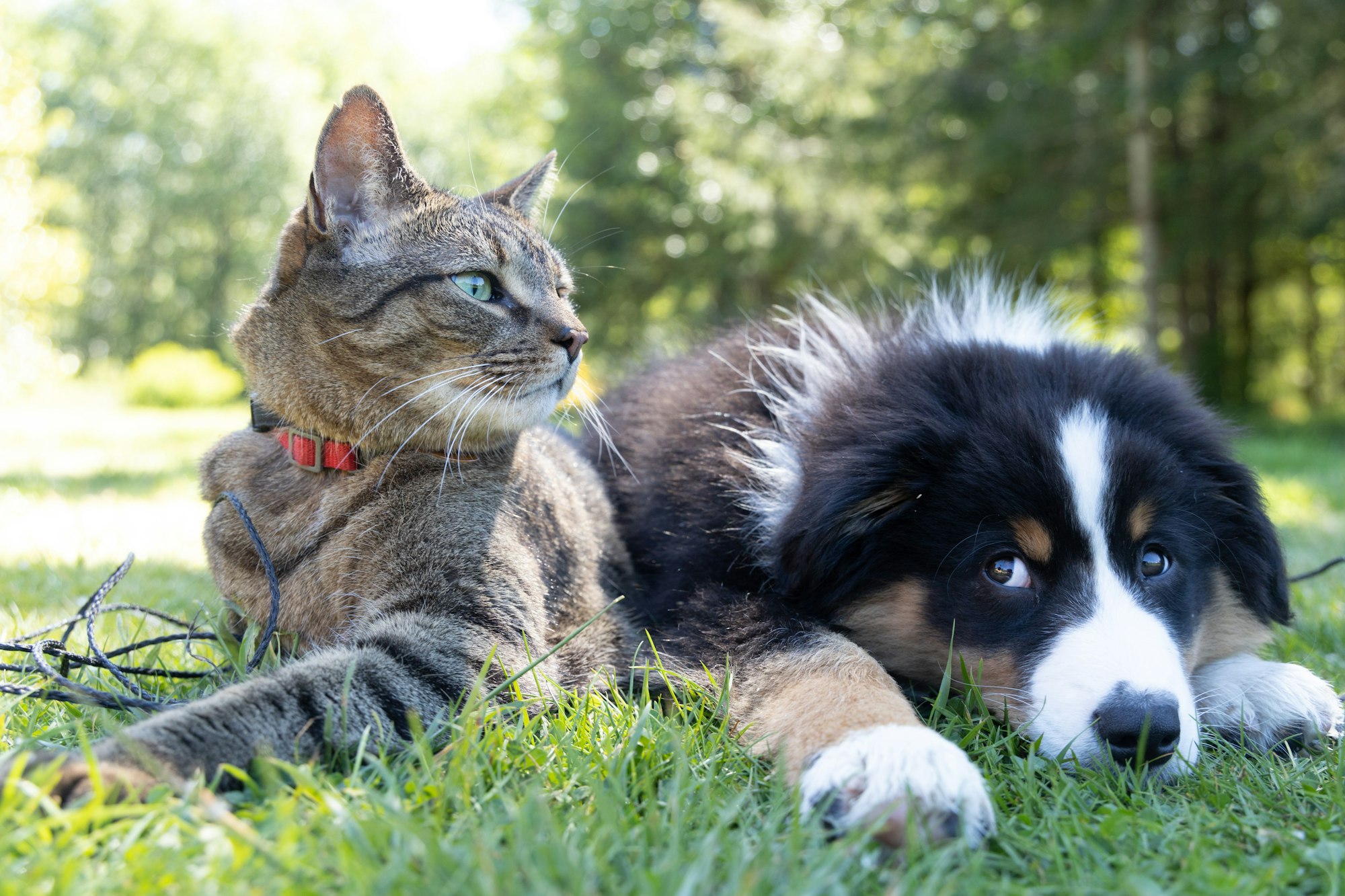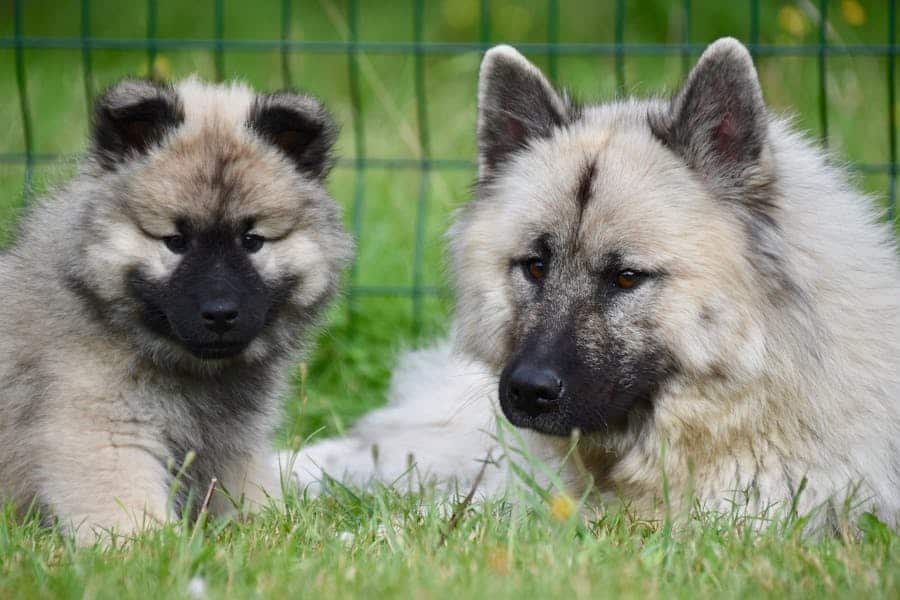Pomskies generally get along with cats if they are properly socialized at an early age. However, their high prey drive inherited from the Siberian Husky may cause them to view cats as potential prey and chase after them.
It is important to note that even with proper socialization, some degree of prey drive may still be present. Nonetheless, Pomskies can be a great fit for families with other pets, including cats, due to their fun and energetic temperament.
Pomskies, a mix between Siberian Huskies and Pomeranians, are known for their adorable appearance and energetic nature. While they make great companions for humans and other dogs, many pet owners wonder if they can get along with cats as well. The answer to this question largely depends on the individual Pomsky’s upbringing and socialization. We will discuss the compatibility of Pomskies with cats and provide insights into their natural instincts. By understanding these factors, you can make an informed decision about introducing a Pomsky into a household that already has a feline friend. Whether you are considering a Pomsky as a new addition to your family or already own a cat and want to bring home a Pomsky, this guide will help you navigate the potential challenges and ensure a harmonious coexistence between the two pets.
Understanding Pomskies And Cats
Pomskies and cats can coexist harmoniously under the right circumstances. Understanding the characteristics of Pomskies and cats is essential in facilitating a successful companionship between the two. While Pomskies are a crossbreed between Siberian Huskies and Pomeranians, known for their energetic and friendly nature, cats tend to be independent and agile creatures. Let’s delve into the traits of both Pomskies and cats to better comprehend how they can interact in the same household.
Characteristics Of Pomskies
Pomskies are a mix of Siberian Huskies and Pomeranians, possessing a combination of traits from both breeds. They are energetic, friendly, and sociable, making them well-suited for households with other pets. Due to their natural pack instincts inherited from the Siberian Husky, Pomskies exhibit excellent leadership abilities, allowing them to coexist harmoniously with other animals when properly socialized.
Characteristics Of Cats
Cats are independent, agile, and sometimes territorial creatures. They are known for their grace and can be cautious when introduced to new animals. Establishing a safe and secure environment for them is crucial for their well-being. While some cats may be curious and outgoing, others may be more reserved and prefer solitude. Understanding the individual personality and behavior of cats is vital in determining their compatibility with Pomskies.
Factors Affecting Co-existence
When it comes to introducing a Pomsky into a household with cats, there are several factors that can affect their ability to co-exist peacefully. Understanding these factors can help you make an informed decision about whether a Pomsky is the right fit for your feline friend. Let’s take a closer look at some of the key considerations:
Pomskies’ Prey Drive
The Pomsky inherits a high prey drive from its Siberian Husky parent, which means they have a natural instinct to chase smaller animals. This can pose a challenge when introducing them to cats. While some Pomskies can learn to live harmoniously with cats, others may view them as prey and exhibit behavior such as chasing or aggressive behavior. It’s important to keep this prey drive in mind when deciding if a Pomsky is compatible with your cat.
Early Socialization
If you are considering adding a Pomsky to a household with cats, early socialization is crucial. Introducing them to cats at a young age can increase the likelihood of them accepting each other. When exposed to cats early on, Pomskies can learn to see them as companions rather than prey. However, it’s important to note that even with proper socialization, some Pomskies may still exhibit a degree of prey drive towards cats.
Training
Training is essential for ensuring a harmonious co-existence between Pomskies and cats. By teaching your Pomsky basic obedience commands and positive reinforcement training, you can help them understand the acceptable behavior around cats. Training can also help redirect their prey drive towards appropriate outlets such as toys or activities, rather than towards your feline companion. Consistency and patience are key when training a Pomsky to get along with cats.
In conclusion, while some Pomskies can get along well with cats, it’s important to consider factors such as their prey drive, early socialization, and training. By understanding and addressing these factors, you can increase the chances of a peaceful co-existence between your Pomsky and feline companion.
Methods For Successful Integration
Introducing Pomskies and cats slowly and in a controlled manner is crucial for successful integration.
Begin by allowing them to become familiar with each other’s scents before any direct interactions.
Gradually introduce them in short, supervised sessions to monitor their behavior.
Always supervise initial interactions between Pomskies and cats to ensure safety for both pets.
Observe their body language and reactions to understand their comfort levels and make adjustments accordingly.
Step in if any signs of aggression or discomfort arise to prevent any conflicts.
Provide separate safe spaces for both Pomskies and cats where they can retreat when needed.
Offer hiding spots, high perches, and cozy areas to make them feel secure in their environment.
Ensure each pet has their own food, water, and litter areas to avoid unnecessary conflicts.
Signs Of Positive Interaction
When introducing a Pomsky to a household with cats, it’s important to observe the signs of positive interaction between the two. Understanding these signs can help ensure a harmonious environment and a strong bond between your Pomsky and your feline friend. Recognizing positive signals from both pets can ease any concerns about their compatibility.
Playful Behavior
Playful behavior is a key indicator of a positive interaction between Pomskies and cats. If your Pomsky and cat engage in interactive play, such as chasing each other or playfully swatting, it’s a reassuring sign that they are comfortable in each other’s presence. Both pets show enthusiasm and joy during their playing, indicating a positive relationship.
Relaxed Body Language
Relaxed body language is another positive indication of their bonding. When both pets are in each other’s company, observe their body language. If the Pomsky and the cat exhibit loose and calm postures, such as relaxed ears, slow blinking, and gentle movements, it signals that they are at ease with one another and enjoy the other’s company.
Mutual Curiosity
When both pets display mutual curiosity, it demonstrates a positive and harmonious bond. If your Pomsky and cat approach each other with friendly curiosity, showing interest in the other’s scent, toys, or activities, it indicates a healthy level of mutual respect and curiosity towards one another. Mutual curiosity fosters a strong foundation for a positive and lasting relationship.
Addressing Challenges
Pomskies and cats can form a beautiful bond, but there may be some challenges along the way. It’s important to understand and address these challenges to ensure a harmonious coexistence between your Pomsky and cat. In this section, we will explore some common challenges and provide helpful solutions.
Negative Interactions
Pomskies have a natural prey drive inherited from their Siberian Husky roots. While some Pomskies may get along well with cats, others may see them as potential prey and engage in negative interactions. These interactions can be in the form of chasing, growling, or even physical altercations.
To prevent negative interactions, it is crucial to introduce your Pomsky and cat gradually. Start by keeping them in separate rooms with a closed door, allowing them to become familiar with each other’s scent. After some time, you can begin supervised interactions through a baby gate or a leash. This will help them establish boundaries and get used to each other’s presence.
It’s important to note that every Pomsky and cat is unique, and their compatibility can vary. Some may become best friends, while others may never fully accept each other. Patience, positive reinforcement, and consistent training are key to fostering a positive relationship.
Preventing Aggression
Aggression can be a concern when introducing a Pomsky to a cat, especially if either pet feels threatened or territorial. It’s essential to create a safe and neutral environment for both animals to reduce the risk of aggressive behaviors.
Here are some tips to prevent aggression:
- Provide separate feeding areas and ensure both pets have their own bowls and space.
- Designate separate resting places to allow each pet to have their own private space.
- Supervise initial interactions and intervene if any signs of aggression arise.
- Use positive reinforcement training techniques to reward calm and appropriate behavior.
Remember, consistency and patience are essential when preventing aggression and fostering a peaceful coexistence between your Pomsky and cat.
Seeking Professional Help
If you’re experiencing persistent negative interactions or escalating aggression between your Pomsky and cat, seeking professional help is advisable. A professional animal behaviorist or trainer can assess the situation and offer specialized guidance tailored to your pets’ specific needs.
They will take into consideration the individual personalities, behaviors, and dynamics of your Pomsky and cat. With their expertise, they can develop a training plan that addresses the challenges you’re facing and guides you on how to safely introduce and manage your pets.
Remember, every situation is unique, and professional help can make a significant difference in creating a harmonious environment for your Pomsky and cat.

Credit: blog.tryfi.com
Testimonials And Expert Insights
Discover if Pomskies Get along With Cats through testimonials and expert insights. When properly introduced at an early age, Pomskies can be accepting companions to cats, but they may exhibit a prey drive if not socialized adequately. These mixed breeds, blending Siberian Husky and Pomeranian traits, make great additions to families with other pets.
Owners’ Experiences
Many pet owners have shared their experiences of Pomskies living harmoniously with cats. According to a Pomsky owner, their furry companions have formed a strong bond filled with playfulness and companionship. Another testimonial highlighted how their Pomsky and cat coexist peacefully, often seen cuddling and grooming each other. These heartwarming experiences show that Pomskies and cats can indeed become the best of friends.
Insights From Veterinarians
Veterinarians emphasize the importance of early socialization for Pomskies and cats. Introducing them at a young age can significantly increase the likelihood of a positive relationship. Proper training and positive reinforcement play a crucial role in fostering a peaceful coexistence between Pomskies and cats. It’s essential to monitor their interactions initially to ensure a smooth and safe integration.
Frequently Asked Questions On Do Pomskies Get Along With Cats
Can A Pomsky Get Along With A Cat?
Yes, Pomskies can get along with cats if introduced at an early age to build acceptance and familiarity.
Are Pomskies Good With Other Pets?
Pomskies are good with other pets. They have leadership abilities and can fit well with families that have other pets. They may have a high prey drive, so early socialization is important.
Do Pomskies Have A High Prey Drive?
Yes, Pomskies have a high prey drive inherited from Siberian Huskies, making them instinctively chase smaller animals.
Are Pomeranians Good With Cats?
Pomeranians usually get along with cats due to their affectionate and adaptable nature, but early socialization is crucial.
Will Pomskies And Cats Get Along Well?
Pomskies are generally good with cats, especially when introduced at an early age.
Conclusion
Pomskies can make great companions for cats when introduced at an early age. Their socialization plays a crucial role in determining their behavior towards cats. While some Pomskies may view cats as prey due to their innate prey drive, proper socialization can help mitigate this behavior.
It’s important to supervise their interactions and provide positive reinforcement to foster a harmonious relationship between Pomskies and cats. With the right introduction and training, Pomskies and cats can coexist peacefully, adding joy and companionship to your household.

